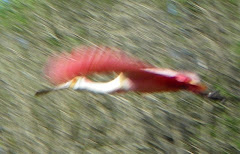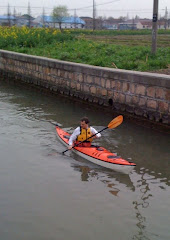 |
| Side-slip. Upright paddle, blade behind hip, blade face engaged |
There are several factors key to success.
1) Start by paddling forward in a straight line
2) As you glide forward, position your blade upright in the water alongside your kayak in a neutral position. That is, so it does not grab the water with either the face or the back of the blade.
3) Position the blade a foot or so behind your hip, a few inches away from the side of your kayak.
4) Gently engage the face of the blade by rotating the leading edge (the blade edge nearest the bow of your kayak) just a few degrees out from the side of your kayak.
5) Your kayak will do one of three things: slide gently sideways, turn toward the paddle, or turn from the paddle. If it turns toward your paddle (as in a bow rudder) move your blade back. If you turn from the paddle (as in a stern draw) move your blade forward until you eliminate the turn.
6) Once you have found the perfect blade position for a side-slip, you'll notice that as your kayak loses forward speed it will begin to turn from your paddle. This will occur because your center of turning will move forward as your kayak slows. To prevent the turn, gradually move your blade forward toward your hip as you slow.
The side-slip is a draw stroke. If you start from standstill to draw sideways, you place your blade and pull your kayak toward it until the blade reaches your hip. When you are moving forward your center of turning/pivot point moves back, so you must position your blade behind your hip for the side-slip and move it gradually forward to your hip as you slow. To make a side-slip work in reverse, begin with your blade forward of your hip and gradually bring it back as you lose speed. You'll need to open the blade toward the stern by rotating the leading edge of the blade away from the hull by a few degrees. The leading edge when you reverse will be the edge nearest the stern.
You'll find more detail in my book "The Art of Kayaking"
 |
| The Art of Kayaking by Nigel Foster |
































